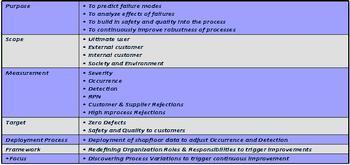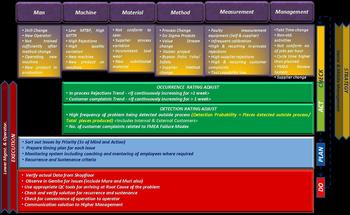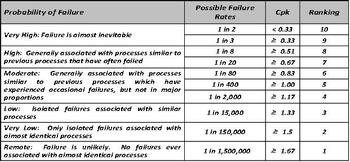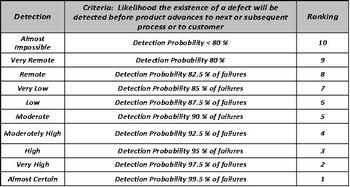Deploying FMEA Intelligently: Minimizing risks & continuously improving shopfloor processes
Add bookmarkMany companies have used Failure Modes & Effects Analysis (FMEA) –a technique used to analyze all the ways something might fail - mainly because it is required by their customers or a Certification Auditor. However, once the initial analysis has been completed the resulting document is often put on a shelf and seldom referred to. That’s a shame because FMEA is a useful way of triggering continuous improvement and improving quality. So how can it be used more intelligently?
Purpose and Scope of an FMEA (Failure Mode & Effect Analysis)
As the name suggests, the prime purpose of an FMEA is to predict failure modes (i.e. what could go wrong) and analyze their effects (i.e. the result of the failing) so that we can continually improve to build safety and quality into products and processes. This helps trigger continual improvement when it is intelligently deployed – the more we understand about what could go wrong, the better our ability to identify what needs to be done to prevent the possible failing.
The table below summarizes the purpose and scope of an FMEA:
Figure 1: Purpose and Scope of FMEA
Triggering the FMEA – "The Check Cycle"
FMEA makes perfect sense in the abstract but most managers find it difficult to apply the FMEA concepts on the shopfloor. Since almost all businesses consist of 6M (Man, Machine, Material, Method, Measurement & Management) the trigger for the Check Cycle is normally provided by continuous monitoring through the 6M x CAPDo Matrix (a variant of the PDCA cycle "Check-Act-Plan-Do"). Senior and Middle Management in the plant monitors these 6M variations and communicates downwards till the operators’ level. Figure 2 illustrates the possible events that could trigger the FMEA. The events, for e.g., Man-skill change, Material-supplier process variation etc., exemplified in the figure below could provide the Check cycle trigger.
Figure 2: Triggering the FMEA through the 6M x CAPDo Matrix
Adjusting Occurrence & Detection: The Act Cycle
In the Act Cycle, the occurrence and/ or detection ratings need to be reviewed and adjusted to current shopfloor conditions. Occurrence, in its simplified form, means all forms of rejections from supplier to customer from concept to delivery and usage at the end customer. Figure-3 shows an example of how Occurrence could be adjusted from the rejection or Cpk data.
Figure-3: Adjusting Occurrence Values
From the Rejection Data and/ or Cpk Data occurrence could be adjusted.
Detection of a defect indicates the failure of the inspection system to detect and arrest the defects at source. If the defect caused by a previous process is detected by subsequent processes then the detection of the origin process must be adjusted upwards and an improvement action must be initiated.
So, % Probability of Detection = Defects detected outside process/ Total Parts produced x 100
The next stage is to calculate the RPN (Risk Priority Number) with the current Occurrence and detection values. Severity for an existing Failure mode typically is not changed unless there has been changes to the design in the process or product specifications. However, for new failure modes which may be discovered during the course of manufacturing, severity needs to be established by the concerned department depending on the organization.
Figure 4: Adjusting Detection rating
Planning, prioritizing & implementing actions: The Plan & Do Cycle
Re-rated RPNs are now prioritized taking into consideration first the severity and then the RPN value. For example, and RPN of 50 with severity of 10 will have a higher priority than an RPN of 120 with severity of 5. The Plan Cycle, therefore, consists of the identifying and prioritizing activities derived from re-rated RPNs and action plans are drawn prioritizing the improvements and establishing systems to monitor and sustain through coaching & mentoring of employees as illustrated in figure-2 above.
The Do Cycle in which root causes are identified through various problem solving tools. These are then implemented and checked continuously for their recurrence and sustenance through a continuous series of Rapid Cycle CAPDo with actual shopfloor data. The Rapid CAPDo Cycle is part of the Shopfloor Daily Management System in which operators are key players to identify Mura (variation) and Muri (stress or burden) which are, more often than not, the causes of 7 Muda (Waste). Also illustrated in Figure-2 above.
Deploying FMEA judiciously helps us to discover process variations and thus trigger improvements continuously. However, the power of the FMEA can be realized once you have tried it by yourself.
Here are some important tips…
- Severity typically remains the same unless changed through product/ process design
- Occurrence is one of the 7 wastes and must be the primary focus of our FMEA
-
Reduction of detection directly by adding Poka-yoke is expensive and has a cascading effect on 6M parameters. Also adding resources like cameras, manpower etc. and processes like additional 100% inspection is not continuous improvement! It can be done only as a immediate containment action! And finally, 100% inspection is never 100% effective for Detection!

























